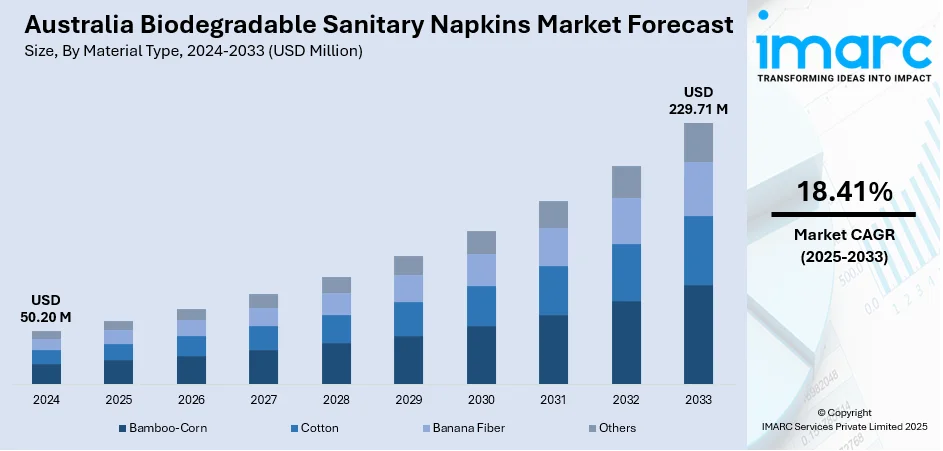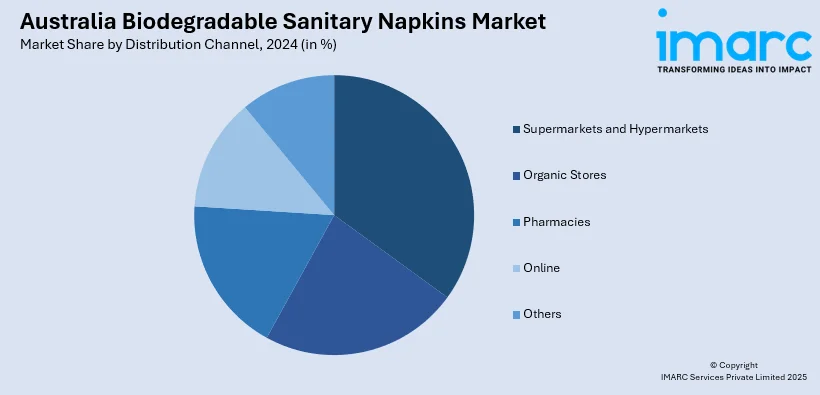
Australia Biodegradable Sanitary Napkins Market Size, Share, Trends and Forecast by Material Type, Distribution Channel, and Region, 2025-2033
Australia Biodegradable Sanitary Napkins Market Overview:
The Australia biodegradable sanitary napkins market size reached USD 50.20 Million in 2024. Looking forward, IMARC Group expects the market to reach USD 229.71 Million by 2033, exhibiting a growth rate (CAGR) of 18.41% during 2025-2033. The market is driven by growing awareness among consumers regarding the environment, government policies promoting the adoption of sustainable products, increasing disposable incomes and health-consciousness among women resulting in increased demand for premium, chemical-free menstrual products.
|
Report Attribute
|
Key Statistics
|
|---|---|
|
Base Year
|
2024 |
|
Forecast Years
|
2025-2033
|
|
Historical Years
|
2019-2024
|
| Market Size in 2024 | USD 50.20 Million |
| Market Forecast in 2033 | USD 229.71 Million |
| Market Growth Rate 2025-2033 | 18.41% |
Australia Biodegradable Sanitary Napkins Market Trends:
Increased Need for Eco-Friendly Menstrual Products
The Australia biodegradable sanitary napkins market share is increasing due to rapid growth as consumers become more aware about the environmental and health implications of their product choices. Conventional sanitary products, which tend to be manufactured from artificial plastics, end up in landfills and pollute the environment. Biodegradable sanitary napkins produced from organic cotton, bamboo, or bioplastics derived from plants are a greener choice. Customers today are also aware of the environmental repercussions of their buy choices, which facilitates a shift in the direction of eco-friendly sanitary products. This is complemented by advocacy campaigns as well as broader access to green options in bricks-and-mortar stores and webstores. Accordingly, companies are innovating in order to cope with consumers' increasing appetite for products aligning with customers' environmental expectations.

To get more information on this market, Request Sample
Government Initiatives Supporting Sustainability
Government initiatives and policies are also playing an important role in encouraging the use of biodegradable sanitary napkins in Australia. For example, local councils provide rebates on the acquisition of reusable and environmental-friendly menstrual products, which promote consumers to purchase sustainable products. These programs seek to minimize the environmental effects of disposable products, which add greatly to landfill waste. By offering monetary benefits, the government is offering sustainable menstrual products at an affordable price to the larger population. Regulations are also tightening, and companies are being advised to provide information about the materials used in their sanitary napkins so that consumers can make a better choice. Such favorable policies are creating a favorable impact on the Australia biodegradable sanitary napkin market growth.
Innovation and Market Accessibility
Product design innovation and material innovation are increasing the popularity of biodegradable sanitary napkins in Australia. Advanced technologies are being incorporated and special materials such as organic cotton, bamboo fibers, and plant-based bioplastics are being utilized to develop effective yet eco-friendly products. These innovations are making the products more functional and are fulfilling the increasing requirement for sustainable solutions. In addition, the widening of distribution channels, such as online shopping websites, supermarkets, and pharmacies, is increasing the availability of these products among consumers throughout the nation. Moreover, subscription services and direct-to-consumer sales are increasing market coverage and convenience for consumers. Consequently, the Australia biodegradable sanitary napkins market outlook is poised for steady growth as these napkins are emerging as a mainstream option among environmentally aware consumers in the region.
Australia Biodegradable Sanitary Napkins Market Segmentation:
IMARC Group provides an analysis of the key trends in each segment of the market, along with forecasts at the regional level for 2025-2033. Our report has categorized the market based on material type, and distribution channel.
Material Type Insights:
- Bamboo-Corn
- Cotton
- Banana Fiber
- Others
The report has provided a detailed breakup and analysis of the market based on the material type. This includes bamboo-corn, cotton, banana fiber, and others.
Distribution Channel Insights:

- Supermarkets and Hypermarkets
- Organic Stores
- Pharmacies
- Online
- Others
A detailed breakup and analysis of the market based on the distribution channel has also been provided in the report. This includes supermarkets and hypermarkets, organic stores, pharmacies, online, and others.
Regional Insights:
- Australia Capital Territory & New South Wales
- Victoria & Tasmania
- Queensland
- Northern Territory & Southern Australia
- Western Australia
The report has also provided a comprehensive analysis of all the major regional markets, which include Australia Capital Territory & New South Wales, Victoria & Tasmania, Queensland, Northern Territory & Southern Australia, and Western Australia.
Competitive Landscape:
The market research report has also provided a comprehensive analysis of the competitive landscape. Competitive analysis such as market structure, key player positioning, top winning strategies, competitive dashboard, and company evaluation quadrant has been covered in the report. Also, detailed profiles of all major companies have been provided.
Australia Biodegradable Sanitary Napkins Market Report Coverage:
| Report Features | Details |
|---|---|
| Base Year of the Analysis | 2024 |
| Historical Period | 2019-2024 |
| Forecast Period | 2025-2033 |
| Units | Million USD |
| Scope of the Report | Exploration of Historical Trends and Market Outlook, Industry Catalysts and Challenges, Segment-Wise Historical and Future Market Assessment:
|
| Material Types Covered | Bamboo-Corn, Cotton, Banana Fiber, Others |
| Distribution Channels Covered | Supermarkets and Hypermarkets, Organic Stores, Pharmacies, Online, Others |
| Regions Covered | Australia Capital Territory & New South Wales, Victoria & Tasmania, Queensland, Northern Territory & Southern Australia, Western Australia |
| Customization Scope | 10% Free Customization |
| Post-Sale Analyst Support | 10-12 Weeks |
| Delivery Format | PDF and Excel through Email (We can also provide the editable version of the report in PPT/Word format on special request) |
Key Questions Answered in This Report:
- How has the Australia biodegradable sanitary napkins market performed so far and how will it perform in the coming years?
- What is the breakup of the Australia biodegradable sanitary napkins market on the basis of material type?
- What is the breakup of the Australia biodegradable sanitary napkins market on the basis of distribution channel?
- What is the breakup of the Australia biodegradable sanitary napkins market on the basis of region?
- What are the various stages in the value chain of the Australia biodegradable sanitary napkins market?
- What are the key driving factors and challenges in the Australia biodegradable sanitary napkins market?
- What is the structure of the Australia biodegradable sanitary napkins market and who are the key players?
- What is the degree of competition in the Australia biodegradable sanitary napkins market?
Key Benefits for Stakeholders:
- IMARC’s industry report offers a comprehensive quantitative analysis of various market segments, historical and current market trends, market forecasts, and dynamics of the Australia biodegradable sanitary napkins market from 2019-2033.
- The research report provides the latest information on the market drivers, challenges, and opportunities in the Australia biodegradable sanitary napkins market.
- Porter's five forces analysis assist stakeholders in assessing the impact of new entrants, competitive rivalry, supplier power, buyer power, and the threat of substitution. It helps stakeholders to analyze the level of competition within the Australia biodegradable sanitary napkins industry and its attractiveness.
- Competitive landscape allows stakeholders to understand their competitive environment and provides an insight into the current positions of key players in the market.
Need more help?
- Speak to our experienced analysts for insights on the current market scenarios.
- Include additional segments and countries to customize the report as per your requirement.
- Gain an unparalleled competitive advantage in your domain by understanding how to utilize the report and positively impacting your operations and revenue.
- For further assistance, please connect with our analysts.
 Request Customization
Request Customization
 Speak to an Analyst
Speak to an Analyst
 Request Brochure
Request Brochure
 Inquire Before Buying
Inquire Before Buying




.webp)




.webp)












